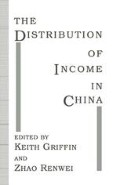Abstract
The distribution of income in China is a subject of great interest and considerable controversy. Part of the interest is due to the sheer size of the country: more than a billion people or one in every five persons on earth lives in China and this alone commands attention and interest. China is also the world’s largest developing country — by some indications one of the poorest of the developing countries — and the combination of a huge population and massive poverty attracts the interest of those concerned with world development. Finally, China is a socialist country undergoing major economic reforms, and after the collapse of communism in eastern and central Europe and in the former Soviet Union, China stands almost alone — with Vietnam and Cuba — in advocating a socialist path under the guidance of the Communist Party. This too focuses interest on China.
Access this chapter
Tax calculation will be finalised at checkout
Purchases are for personal use only
Preview
Unable to display preview. Download preview PDF.
Notes and references
This is not intended to denigrate the earlier work of others on income inequality and poverty, much of which is of high quality and was valuable at the time of original publication. Indeed several of the authors included in this volume have contributed to the literature on income distribution in China and their work too is now of limited use. See, for example, Keith Griffin and Ashwani Saith, Growth and Equality in Rural China, Bangkok: Maruzen, 1981
Keith Griffin, ed., Institutional Reform and Economic Development in the Chinese Countryside, London: Macmillan, 1984; Keith Griffin, ‘Income Differentials in Rural China: Comment,’ China Quarterly, December 1982; Keith Griffin and Kimberley Griffin, ‘Institutional Change and Income Distribution in the Chinese Countryside,’ Oxford Bulletin of Economics and Statistics, August 1983; Keith Griffin and Ashwani Saith, ‘The Pattern of Income Inequality in Rural China,’ Oxford Economic Papers, March 1982
Azizur Rahman Khan, |‘The Distribution of Income in Rural China,’ in ILO, Poverty and Landlessness in Rural Asia, Geneva: ILO, 1977
Carl Riskin, China’s Political Economy, New York: Oxford University Press, 1987, Ch. 10.
William Hinton, The Great Reversal, New York: Monthly Review Press, 1990.
Peter Nolan, The Political Economy of Collective Farms, Boulder: Westview Press, 1988.
UNDP, Human Development Report 1991, New York: Oxford University Press, 1991, Annex Table 17, pp. 152–3.
This pattern was anticipated in Keith Griffin, ed., Institutional Reform and Economic Development in the Chinese Countryside, London: Macmillan, 1984.
Editor information
Editors and Affiliations
Copyright information
© 1993 Keith Griffin and Zhao Renwei
About this chapter
Cite this chapter
Griffin, K., Renwei, Z. (1993). Introduction. In: Griffin, K., Renwei, Z. (eds) The Distribution of Income in China. Palgrave Macmillan, London. https://doi.org/10.1007/978-1-349-23026-6_1
Download citation
DOI: https://doi.org/10.1007/978-1-349-23026-6_1
Publisher Name: Palgrave Macmillan, London
Print ISBN: 978-1-349-23028-0
Online ISBN: 978-1-349-23026-6
eBook Packages: Palgrave Economics & Finance CollectionEconomics and Finance (R0)

